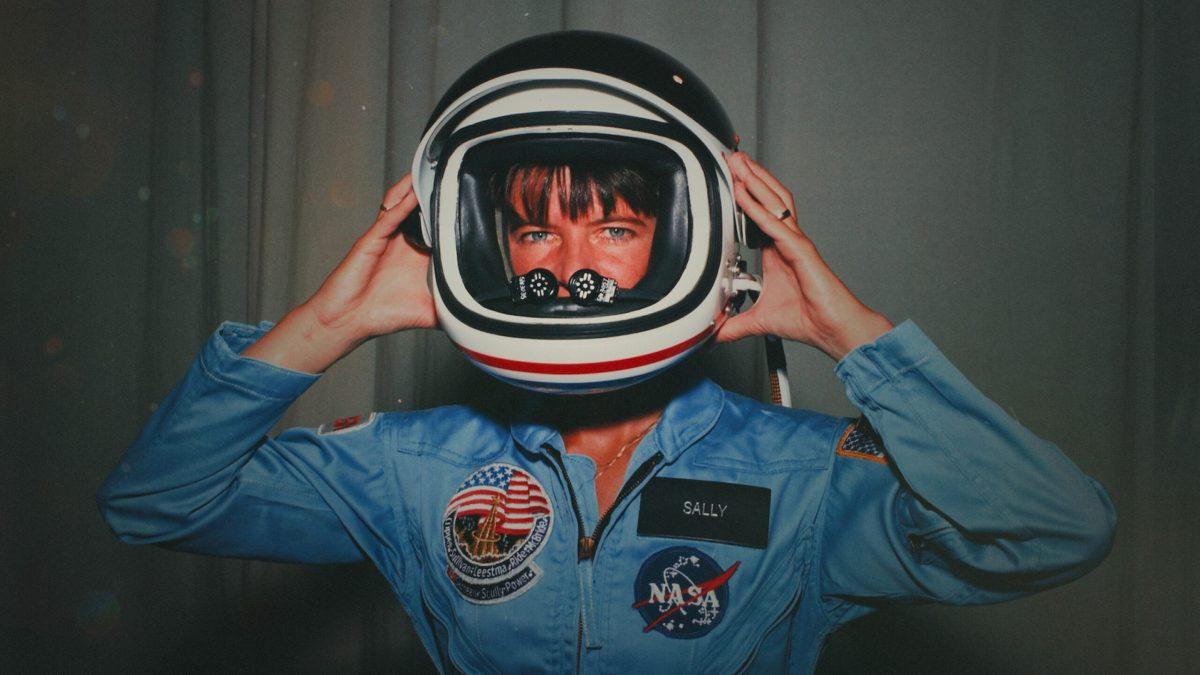
NASA Astronaut Sally Ride posing with her space helmet during her time in training as a mission specialist for NASA's STS-7 spaceflight. (Credit: NASA)
“Sally” highlights the phenomenal life and career of astronaut and physicist Sally Ride, the first American woman in space
“Let Sally be Sally,” is what Tam O’Shaughnessy says of her late partner, Sally Ride. Told through O’Shaughnessy’s eyes, the documentary “Sally” was showcased at the True/False Film Festival from Feb. 28 through March 2. Director Cristina Costantini combines archival footage, intimate interviews and staged scenes to portray the remarkable life the astronaut and physicist led.
Ride made her mark on history as the first American woman to fly in space on June 18, 1983. Ride was selected as a mission specialist for the STS-7 mission aboard the space shuttle Challenger. Leading up to this monumental moment in history, Ride fought continuous, subtle misogyny as one of the first six women integrated into NASA’s astronaut programs in the late ‘70s. Ride was a part of Astronaut Group 8, which was formed in 1978, and was the first to embrace women and astronauts of color.
Through NASA’s footage of Ride and her colleagues, the documentary beautifully encapsulates Ride’s determination and humble self-identity. As she carelessly flicks switches, presses buttons and strides between the men in different NASA control rooms, she proves her grit in a male-dominated field.
The film combines both Ride’s ambition in and out of the stars. As a closeted lesbian in NASA’s Astronaut Group 8, Ride was facing an internal struggle beyond the existing nerve-wracking expectations as an astronaut. As O’Shaughnessy explains, their relationship wasn’t made public until her death in 2012, revealing their partnership in her obituary.
As the first American woman in space, Ride became a star and opened the eyes of hundreds of thousands of women across the nation. After six days, Ride landed back on Earth on June 28, 1983, now an American icon overwhelmed by journalists, photographers and curious citizens eager to learn more about her and her experiences in space. As shown in the documentary, this was a nightmare for Ride, and she slowly retreated from the public eye for many years.
The documentary incorporates interview panels with Ride and her fellow astronauts that accompanied her on the 1983 mission. Miraculously, Ride remained composed when asked blatantly misogynistic questions. As the male astronauts were asked about the mission and their expertise in the field, Ride was asked if she believed the intensity of the mission would affect her ability to have children. Ride simply smiled, offered a sarcastic comment and moved on.
With O’Shaughnessy narrating the life of the trailblazing astronaut, the film offered a more sentimental outlook on the liveliness of Ride’s passion for her career. Rather than simply highlighting her achievements and historical impact on both NASA and women in male-dominated fields after her death, the documentary dove deeper, showing clips of her floating around the spaceship on the 1983 mission with a wide smile or shutting down misogynistic and sexist questions asked by reporters.
As O’Shaughnessy said, Ride was hesitant to embrace their relationship publicly because of the political and social atmosphere of the time. Ride knew to keep her personal life out of the public eye, as the documentary mentioned public figures like Billie Jean King, a prominent tennis player, lose support because of their sexuality, meaning Ride could risk losing her job. As King’s affair with her assistant, a woman, aired out, Ride remained reserved in order to protect both herself and O’Shaughnessy.
As well as portraying a captivating message, the film truly captured the atmosphere of the ‘70s and ‘80s with the archival footage used throughout the documentary, which showed NASA astronauts with timely fringes, poofy perms and lots of colorful outfits. Though seemingly subtle and purposeful, this use of footage, photographs and music from the time forcefully inserts the viewer into the scenes. This emphasizes how marginalized communities began to gain representation in governmental institutions, like NASA, as we see more women and people of color emerging in the field throughout the documentary.
As well as using footage, photos and recent interviews, the film also uses actors to recreate a few memories that O’Shaughnessy narrates, a smile on her face as she reminiscences. This includes some more personal moments in her and Ride’s relationship, as well as some of Ride in a spaceship before her first mission.
O’Shaughnessy described Ride’s retirement from NASA after the Space Shuttle Challenger exploded on Jan. 28, 1986. After the explosion took the lives of all seven crew members aboard, Ride became entangled in the investigation regarding the Challenger’s explosion. As a member of the Rogers Commission, a presidential commission to investigate the disaster, Ride quickly realized that, as O’Shaughnessy put it, NASA was not what it seemed.
After her split from NASA, Ride and O’Shaughnessy founded Sally Ride Science in 2001, which is a nonprofit based out of the University of California, San Diego. The program was started to encourage young girls and women to become involved in STEM. Through this program, Ride’s legacy and activism efforts live on.
Overall, the documentary painted an intimate portrait of the American icon Sally Ride. Apart from highlighting an extraordinary astronaut and staunch activist for women and girls in STEM, “Sally” shows the pioneering woman in a new light as an astronaut, activist and human, both in and out of Earth’s atmosphere.
You can keep up with The Maneater’s 2025 True/False Film Fest coverage here.
Edited by Molly Levine | [email protected]
Copy edited by Emma Short | [email protected]
Edited by Emilia Hansen | [email protected]
Edited by Annie Goodykoontz | [email protected]